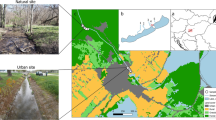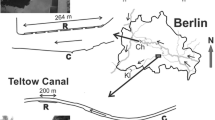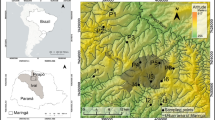Abstract
The extent of catchment impervious surface is recognised to be an important factor associated with the condition of urban freshwater streams. We tested the hypothesis that the degree of catchment imperviousness predicted the relative ecological condition of freshwater reaches within the network of streams and rivers in the partly urbanised Georges River catchment in temperate south-eastern Australia. The 2-year study involved two spring and two autumn assessments of water quality (chemical and physical) and ecological condition, using benthic macroinvertebrates, riparian vegetation and calculation of catchment imperviousness. The study revealed that highly urbanised streams had strongly degraded water quality and macroinvertebrate communities, compared to clean non-urban reference streams. We found three clear groups of sites with varying degrees of ecological condition, being categorised according to the level of catchment effective imperviousness (low <5.0 %, moderate = 5.0–18.0 % and high >18.0 %). Water pollution also varied according to these categories. A combination of two water chemistry attributes (total nitrogen and calcium), along with catchment imperviousness and riparian vegetation condition, were identified as being the factors most strongly associated with variation of macroinvertebrate communities. Based on our results, we recommend that protection of the ecological condition of streams should focus on not only water quality but also include catchment imperviousness and riparian vegetation condition.




Similar content being viewed by others
References
ANZECC (Australian and New Zealand Environment and Conservation Council), & ARMCANZ (Agriculture and Resource Management Council of Australia and New Zealand). (2000). Australian and New Zealand guidelines for fresh and marine waters. National water quality management strategy paper no. 4. Canberra: Australian and New Zealand Environment and Conservation Council/Agriculture and Resource Management Council of Australia and New Zealand.
APHA (American Public Health Association). (1998). Standard methods for the examination of water and wastewater (20th ed.). Washington, DC: American Public Health Association.
Beavan, L., Sadler, J., & Pinder, C. (2001). The invertebrate fauna of a physically modified urban river. Hydrobiologia, 445, 97–108.
Booth, D. B., & Jackson, C. R. (1997). Urbanization of aquatic systems—degradation thresholds, stormwater detention, and the limits of mitigation. Journal American Water Resource Association, 33, 1077–1090.
Bowman, M. F., & Bailey, R. C. (1997). Does taxonomic resolution affect the multivariate description of the structure of freshwater benthic macroinvertebrate communities? Canadian Journal of Fisheries and Aquatic Sciences, 54, 1802–1807.
Cairns, J., Jr., & Pratt, J. R. (1993). A history of biological monitoring using benthic macroinvertebrates. In D. M. Rosenberg & V. H. Resh (Eds.), Freshwater biomonitoring and benthic macroinvertebrates (pp. 10–27). London: Chapman & Hall.
Chessman, B. C. (1995). Rapid assessment of rivers using macroinvertebrates: a procedure based on habitat-specific sampling, family level identification and a biotic index. Australian Journal of Ecology, 20, 122–129.
Chessman, B. C. (2003a). New sensitivity grades for Australian river macroinvertebrates. Marine and Freshwater Research, 54, 95–103.
Chessman, B. C. (2003b). SIGNAL 2—a scoring system for macro-invertebrate (‘water bugs’) in Australian Rivers, monitoring river heath initiative technical report no 31. Canberra: Commonwealth of Australia.
Clarke, K. R. (1993). Non-parametric multivariate analyses of changes in community structure. Australian Journal of Ecology, 18, 117–143.
Clarke, K. R., & Ainsworth, M. (1993). A method of linking multivariate community structure to environmental variables. Marine Ecology Progress Series, 92, 205–219.
Cohen, J. E. (2003). Human population: the next century. Science, 302, 1172–1175.
Cuffney, T. F., Zappia, H., Giddings, E. M. P., & Coles, J. F. (2005). Effects of urbanization on benthic macroinvertebrate assemblages in contrasting environmental settings: Boston, Massachusetts; Birmingham, Alabama; and Salt Lake City, Utah. American Fisheries Society Symposium, 47, 361–408.
Davies, P. J., Wright, I. A., Jonasson, O. J., Findlay, S. J., & Burgin, S. (2010a). Impact of urban development on stream health with comment on aquatic macroinvertebrate monitoring protocols. Aquatic Ecology, 44, 685–700.
Davies, P. J., Wright, I. A., Jonasson, O. J., & Findlay, S. J. (2010b). Impact of concrete and PVC pipes on urban water chemistry. Urban Water Journal, 7, 233–241.
DEST, EPA, & WRDC. (1994). River bioassessment manual. Version 1.0, National River Processes and Management Program, Monitoring River Health Initiative. Canberra: Department of the Environment, Sport and Territories, Environment Protection Agency, and Land and Water Research and Development Corporation.
Donohue, I., McGarrigle, M. L., & Mills, P. (2006). Linking catchment characteristics and water chemistry with the ecological status of Irish rivers. Water Research, 40, 91–98.
Dunn, T., & Leopold, L. B. (1978). Water in environmental planning. San Francisco: Freeman.
Gibbs, R. J. (1970). Mechanisms controlling world water chemistry. Science, 170, 1088–1090.
Gooderham, J., & Tsyrlin, E. (2002). The waterbug book—guide to the freshwater macroinvertebrates of temperate Australia. Melbourne: CSIRO.
Gregory, K. J., Davis, R. J., & Downs, P. W. (1992). Identification of river channel change due to urbanization. Applied Geography, 12, 299–318.
Hatt, B. E., Fletcher, T. D., Walsh, C. J., & Taylor, S. L. (2004). The influence of urban density and drainage infrastructure on the concentrations and loads of pollutants in small streams. Environmental Management, 34, 112–124.
Hawking, J. H., & Smith, F. J. (1997). Colour guide to invertebrates of Australian inland waters. Identification guide no. 8. Albury: Cooperative Research Centre for Freshwater Ecology.
Hayes, W. J., & Buckney, R. T. (1995). Anthropogenic effects on the chemical characteristics of freshwater streams near Sydney Australia, during low flows. Lakes & Reservoirs: Research and Management, 1, 39–48.
Hession, W. C., Johnson, T. E., Charles, D. F., Hart, D. D., Horwitz, R. J., Kreeger, D. A., et al. (2000). Ecological benefits of riparian reforestation in urban watersheds: study design and preliminary results. Environmental Monitoring and Assessment, 63, 211–222.
Jansen, A., Robertson, A., Thompson, L., & Wilson, A. (2004). Development and application of a method for the rapid appraisal of riparian condition, River Management Technical Guideline no. 4. Canberra: Land & Water Australia.
Jones, R. C., & Clarke, C. C. (1987). Impact of watershed urbanisation on stream insect communities. Water Resources Bulletin, 23, 1047–1055.
King, S. A., & Buckney, R. T. (2000). Urbanization and exotic plants in northern Sydney streams. Austral Ecology, 25, 455–462.
Krebs, C. (1989). Ecological methodology. New York: Harper Collins.
Lake, J. C., & Leishman, M. R. (2004). Invasion success of exotic plants in natural ecosystems: the role of disturbance, plant attributes and freedom from herbivores. Biological Conservation, 117, 215–226.
Lee, J. W., Bang, K. W., Ketchum, L. H., Jr., Choe, J. S., & Yu, M. J. (2002). First flush analysis of urban storm runoff. The Science of the Total Environment, 293, 163–175.
Marchant, R., Barmutta, L. A., & Chessman, B. C. (1994). Preliminary study of the ordination and classification of macroinvertebrate communities from running waters in Victoria, Australia. Australian Journal of Marine & Freshwater Research, 45, 945–962.
Markich, S. J., & Brown, P. L. (1998). Relative importance of natural and anthropogenic influences on the fresh surface water chemistry of the Hawkesbury-Nepean River, south-eastern Australia. The Science of the Total Environment, 217, 201–230.
McKinney, M. L. (2006). Urbanization as a major cause of biotic homogenization. Biological Conservation, 127, 247–260.
Miserendino, L. M., & Masi, C. I. (2010). The effects of land use on environmental features and functional organization of macroinvertebrate communities in Patagonian low order streams. Ecological Indicators, 10, 311–319.
Morgan, R. P., & Cushman, S. E. (2005). Urbanization effects on stream fish assemblages in Maryland, USA. Journal of the North American Benthological Society, 24, 643–655.
Morse, C. C., Huryn, A. D., & Cronan, C. (2003). Impervious surface area as a predictor of the effects of urbanisation on stream insect communities in Maine, USA. Environmental Monitoring and Assessment, 89, 95–127.
Paul, M. J., & Meyer, J. L. (2001). Streams in the urban landscape. Annual Review Of Ecology And Systematics, 32, 333–365.
Potapova, M., & Charles, D. F. (2003). Distribution of benthic diatoms in US rivers in relation to conductivity and ionic composition. Freshwater Biology, 48, 1311–1328.
Rosenberg, D. M., & Resh, V. H. (1993). Freshwater biomonitoring and benthic macroinvertebrates. New York: Chapman & Hall.
Roy, A. H., Rosemond, M. J., Paul, M. J., Leigh, D. S., & Wallace, J. B. (2003). Stream macroinvertebrate response to catchment urbanisation (Georgia, USA). Freshwater Biology, 48, 329–346.
Stranko, S. A., Hilderbrand, R. H., Morgan, R. P., Staley, M. W., Becker, A. J., Roseberry-Lincoln, A., et al. (2008). Brook trout declines with land cover and temperature changes in Maryland. Journal of the North American Benthological Society, 28, 1223–1232.
Sydney Metropolitan Catchment Management Authority (SMCMA). (2012). Georges River. (http://www.sydney.cma.nsw.gov.au/georgesriver.html). Accessed 5 July 2012.
Walsh, C. J., Sharpe, A. K., Breen, P. F., & Sonneman, J. A. (2001). Effects of urbanisation on streams of the Melbourne region, Victoria, Australia. I. Benthic macroinvertebrate communities. Freshwater Biology, 46, 535–551.
Walsh, C. J., Leonard, A. W., Ladson, A. R., & Fletcher, T. D. (2004). Urban stormwater and the ecology of streams. Canberra: Cooperative Research Centre for Freshwater Ecology and Cooperative Research Centre for Catchment Hydrology.
Walsh, C. J., Fletcher, T. D., & Ladson, A. R. (2005). Stream restoration in urban catchments through re-design stormwater systems: looking to the catchment to save the stream. Journal of the North American Benthological Society, 24, 690–750.
Walsh, C. J., Roy, A. H., Feminella, J. W., Cottingham, P. D., Groffman, P. M., & Morgan, R. P., II. (2005). The urban stream syndrome: current knowledge and the search for a cure. Journal of the North American Benthological Society, 24, 706–723.
Walsh, C. J., Waller, K. A., Gehling, J. E., & MacNally, R. (2007). Riverine invertebrate assemblages are degraded more by catchment urbanisation than by deforestation. Freshwater Biology, 52, 574–587.
Walters, D. M., Roy, A. H., & Leigh, D. S. (2009). Environmental indicators of macroinvertebrate and fish assemblage integrity in urbanizing watersheds. Ecological Indicators, 9, 1222–1233.
Warwick, R. M. (1993). Environmental impact studies on marine communities: pragmatical considerations. Australian Journal of Ecology, 18, 63–80.
White, M. D., & Greer, K. A. (2004). The effects of watershed urbanization on the stream hydrology and riparian vegetation of Los Penasquitos Creek, California. Landscape and Urban Planning, 74, 125–138.
Wright, I. A., Chessman, B. C., Fairweather, P. G., & Benson, L. J. (1995). Measuring the impact of sewage effluent of an upland stream: the effect of different levels of taxonomic resolution and quantification. Australian Journal of Ecology, 20, 142–149.
Wright, I. A., Davies, P. J., Jonasson, O. J., & Findlay, S. J. (2011). A new type of water pollution: concrete drainage infrastructure and geochemical contamination of urban waters. Marine and Freshwater Research, 62, 1–7.
Acknowledgments
This study was supported by the Georges River Combined Councils' Committee, the NSW Government and Commonwealth Government. Community volunteers generously assisted with field work. All sampling was undertaken with permission of landholders and the NSW National Parks and Wildlife Service.
Author information
Authors and Affiliations
Corresponding author
Rights and permissions
About this article
Cite this article
Tippler, C., Wright, I.A. & Hanlon, A. Is Catchment Imperviousness a Keystone Factor Degrading Urban Waterways? A Case Study from a Partly Urbanised Catchment (Georges River, South-Eastern Australia). Water Air Soil Pollut 223, 5331–5344 (2012). https://doi.org/10.1007/s11270-012-1283-5
Received:
Accepted:
Published:
Issue Date:
DOI: https://doi.org/10.1007/s11270-012-1283-5




